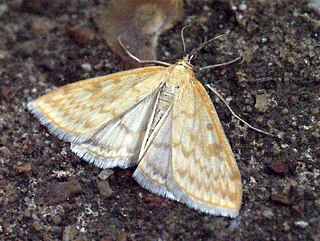
Colias croceus, clouded yellow, is a small butterfly of the family Pieridae, the yellows and whites.

The mint moth is a small moth from the family Crambidae, also known by the common name Small Purple and Gold.

Heliothis peltigera, also known as the bordered straw, is a species of moth of the family Noctuidae.

Agriphila geniculea, the elbow-striped grass-veneer, is a species of moth of the family Crambidae. It was first described by Adrian Hardy Haworth in 1811.

Agriphila tristella, the common grass-veneer, is a species of moth of the family Crambidae found in Europe and Asia.

Cataclysta lemnata, the small china-mark, is a moth species of the family Crambidae. It is found in Europe, Morocco and Iran.

Catoptria falsella, the chequered grass-veneer, is a species of moth of the family Crambidae.

Catoptria margaritella, the pearl-band grass veneer, is a species of moth of the family Crambidae. It was described by Michael Denis and Ignaz Schiffermüller in 1775 and is found in Europe.

Catoptria pinella is a species of moth of the family Crambidae. It is found in Europe, North Africa and across the Palearctic.

Chilo phragmitella is a species of moth of the family Crambidae, sometimes referred to by the vernacular names wainscot veneer or reed veneer. It was first described by Jacob Hübner between 1805 and 1810 as Tinea phragmitella, and is the type species of the genus Chilo.

Chrysoteuchia culmella, the garden grass-veneer, is a species of moth of the family Crambidae. It was first described by Carl Linnaeus in his 1758 10th edition of Systema Naturae. It is found in Europe.

Palpita vitrealis, common name jasmine moth or white pearl, is a species of moth of the family Crambidae.

Udea ferrugalis, the rusty dot pearl, is a moth of the family Crambidae. The species was first described by Jacob Hübner in 1796.

Sitochroa verticalis, common name lesser pearl, is a species of moth of the family Crambidae.

Eudonia mercurella is a species of moth of the family Crambidae. It is found in Europe, western China, Iran, Lebanon, Turkey, and north-western Africa.

Parapoynx stratiotata, the ringed china-mark, is a moth of the family Crambidae. The species was first described by Carl Linnaeus in his 1758 10th edition of Systema Naturae. It is found in Europe where the distribution area extends in the north to the British Isles including Ireland and in the south to Sardinia, Sicily and Greece. The species is also found across the Palearctic in North Africa, Lebanon, Turkey, Azerbaijan, Kyrgyzstan, Uzbekistan and China..

Euchromius ocellea, the necklace veneer or belted grass-veneer, is a cosmopolitan migratory species of moth of the family Crambidae, first described by Adrian Hardy Haworth in 1811. It has Hodges number 5454.

Scopula rubiginata, the tawny wave, is a moth of the family Geometridae. The species was first described by Johann Siegfried Hufnagel in 1767.

Eudonia pallida is a species of moth of the family Crambidae. It was described by John Curtis in 1827 and is known from most of Europe. Its alternative English name is the Marsh Grey.

Eublemma parva, the small marbled, is a moth of the family Erebidae. The species was first described by Jacob Hübner in 1808.





















